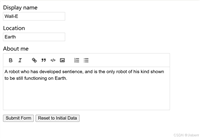基本概念与作用说明
ref属性
ref是vue提供的一种特殊的属性,用于在模板中注册引用信息。当我们需要在javascript中访问dom元素或子组件实例时,可以使用ref属性。vue会在组件渲染完成后,将对应的dom元素或组件实例保存到this.$refs对象中。
动态添加ref
在某些情况下,我们需要根据条件动态地添加ref属性。vue提供了多种方式来实现这一点,包括使用计算属性、条件渲染等。
示例一:基本的ref使用
首先,我们来看一个基本的ref使用示例,通过ref获取dom元素并在方法中操作它。
父组件
<template>
<div>
<h3>父组件</h3>
<input ref="inputref" type="text" placeholder="输入一些文本">
<button @click="focusinput">聚焦输入框</button>
</div>
</template>
<script>
export default {
methods: {
focusinput() {
this.$refs.inputref.focus(); // 获取dom元素并聚焦
}
}
};
</script>
在这个示例中,我们通过ref="inputref"为输入框添加了一个引用,并在按钮点击时通过this.$refs.inputref.focus()聚焦输入框。
示例二:动态添加ref
接下来,我们来看一个动态添加ref的示例。假设我们有一个列表,每个列表项都需要根据条件动态添加ref。
父组件
<template>
<div>
<h3>父组件</h3>
<ul>
<li v-for="(item, index) in items" :key="index" :ref="getref(index)">
{{ item }}
</li>
</ul>
<button @click="highlightfirstitem">高亮第一个列表项</button>
</div>
</template>
<script>
export default {
data() {
return {
items: ['苹果', '香蕉', '橙子']
};
},
methods: {
getref(index) {
return index === 0 ? 'firstitem' : null; // 只为第一个列表项添加ref
},
highlightfirstitem() {
if (this.$refs.firstitem) {
this.$refs.firstitem[0].style.backgroundcolor = 'yellow'; // 高亮第一个列表项
}
}
}
};
</script>
在这个示例中,我们通过v-for循环生成列表项,并使用getref方法根据索引动态添加ref。只有第一个列表项会被添加ref,并在按钮点击时高亮显示。
示例三:使用计算属性动态添加ref
有时我们需要根据组件的状态动态添加ref。vue的计算属性可以很好地解决这个问题。
父组件
<template>
<div>
<h3>父组件</h3>
<input v-model="searchtext" type="text" placeholder="搜索列表项">
<ul>
<li v-for="(item, index) in filtereditems" :key="index" :ref="getref(item)">
{{ item }}
</li>
</ul>
<button @click="highlightselecteditem">高亮选中的列表项</button>
</div>
</template>
<script>
export default {
data() {
return {
searchtext: '',
items: ['苹果', '香蕉', '橙子'],
selecteditem: '苹果'
};
},
computed: {
filtereditems() {
return this.items.filter(item => item.includes(this.searchtext));
}
},
methods: {
getref(item) {
return item === this.selecteditem ? 'selecteditemref' : null; // 根据选中的项动态添加ref
},
highlightselecteditem() {
if (this.$refs.selecteditemref) {
this.$refs.selecteditemref[0].style.backgroundcolor = 'yellow'; // 高亮选中的列表项
}
}
}
};
</script>
在这个示例中,我们使用计算属性filtereditems来过滤列表项,并根据selecteditem动态添加ref。在按钮点击时,高亮显示选中的列表项。
示例四:动态添加ref到子组件
我们也可以将ref动态添加到子组件中,以便在父组件中调用子组件的方法。
父组件
<template>
<div>
<h3>父组件</h3>
<child-component v-for="(item, index) in items" :key="index" :ref="getref(item)">
{{ item }}
</child-component>
<button @click="callchildmethod">调用子组件方法</button>
</div>
</template>
<script>
import childcomponent from './childcomponent.vue';
export default {
components: {
childcomponent
},
data() {
return {
items: ['苹果', '香蕉', '橙子'],
selecteditem: '苹果'
};
},
methods: {
getref(item) {
return item === this.selecteditem ? 'selectedchild' : null; // 根据选中的项动态添加ref
},
callchildmethod() {
if (this.$refs.selectedchild) {
this.$refs.selectedchild[0].dosomething(); // 调用子组件的方法
}
}
}
};
</script>
子组件
<template>
<div>
<slot></slot>
</div>
</template>
<script>
export default {
methods: {
dosomething() {
console.log('子组件的方法被调用了');
}
}
};
</script>
在这个示例中,父组件通过getref方法根据selecteditem动态添加ref到子组件。在按钮点击时,调用选中的子组件的方法。
示例五:使用vue的生命周期钩子动态添加ref
在某些情况下,我们可能需要在组件的生命周期钩子中动态添加ref。vue提供了多个生命周期钩子,如mounted和updated,可以在这些钩子中进行操作。
父组件
<template>
<div>
<h3>父组件</h3>
<input v-model="searchtext" type="text" placeholder="搜索列表项">
<ul>
<li v-for="(item, index) in filtereditems" :key="index" :ref="getref(item)">
{{ item }}
</li>
</ul>
<button @click="highlightselecteditem">高亮选中的列表项</button>
</div>
</template>
<script>
export default {
data() {
return {
searchtext: '',
items: ['苹果', '香蕉', '橙子'],
selecteditem: '苹果'
};
},
computed: {
filtereditems() {
return this.items.filter(item => item.includes(this.searchtext));
}
},
methods: {
getref(item) {
return item === this.selecteditem ? 'selecteditemref' : null; // 根据选中的项动态添加ref
},
highlightselecteditem() {
if (this.$refs.selecteditemref) {
this.$refs.selecteditemref[0].style.backgroundcolor = 'yellow'; // 高亮选中的列表项
}
}
},
updated() {
this.highlightselecteditem(); // 在组件更新后高亮选中的列表项
}
};
</script>
在这个示例中,我们在updated生命周期钩子中调用highlightselecteditem方法,确保在组件更新后高亮选中的列表项。
实际工作中的使用技巧
在实际开发过程中,处理动态添加ref可能会遇到各种挑战。以下是一些有用的技巧:
- 命名规范:使用有意义的
ref名称,避免使用模糊不清的名字,如ref1或ref2。 - 错误处理:在访问
this.$refs时添加错误处理逻辑,确保程序的健壮性。 - 性能优化:避免在不必要的地方添加
ref,以免影响性能。 - 代码复用:将常用的
ref操作封装成可复用的组件或混入(mixins),减少重复代码。 - 测试:编写单元测试和端到端测试,确保功能的正确性和稳定性。
总之,通过上述示例和技巧,我们可以看到vue框架在处理动态添加ref方面的强大能力和灵活性。希望本文能为你的vue项目开发带来启发和帮助。
到此这篇关于vue中动态添加ref的方法详解的文章就介绍到这了,更多相关vue动态添加ref内容请搜索代码网以前的文章或继续浏览下面的相关文章希望大家以后多多支持代码网!






发表评论